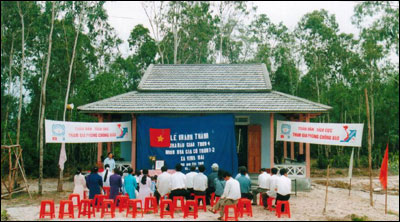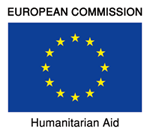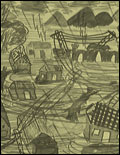| home |
Projects
The European Commission's Dipecho/DWF Project

Promoting Preventive Strengthening in Central Vietnam
 |
‘It is crucial that disaster preparedness measures are developed together with the communities they are targeting taking into account for example their knowledge on disasters and their social structure. Only then will they be effective and allow to save lives and livelihoods. It is on exactly this basis that we have worked successfully with DW since 2002’ Cécile Pichon, DIPECHO technical assistant for South-East Asia |
Following two DWF programmes (2003 – 2004, and 2004 - 2006) in Viet Nam supported by the European Commission Humanitarian Office (ECHO) special programme for Disaster Prevention (Dipecho), in 2006 DWF was once again supported by the European Commission Office for Humanitarian Aid (ECHO) as part of the Fifth Dipecho Action Plan for Southeast Asia.
A Programme to Protect the Home & Family Investment
In the face of annual floods, storms and typhoons that destroy property and investment, the DW programme in Thua Thien Hué Province, central Viet Nam demonstrates a strategy that channels resources, including each family’s own resources, into prevention rather than reconstruction. The programme helps families reduce the vulnerability of their home to storm damage and associated effects, and thus protects the investment they have made in building their home – and through this creates an environment of greater family stability in which they can focus on production, health and education.
A long term aim for DW is to see family and community based preventive actions adopted as a complementary part of national disaster reduction and poverty reduction strategies. In 2006 this is happening, with solid provincial support.
Building on the past 7 years experience in Viet Nam DW works with poor communities in Thia Thien Hué Province, and has extended some activities to Quang Tri province in 2006, and possible into Da Nang as well in late 2006/07.
The strategy is to reduce material and economic vulnerability of families and communities caused by natural disasters in central Viet Nam.
The focus is on encouraging and assisting families to reduce their vulnerability in a sustainable manner.
The idea at centre of the project is to encourage families to apply the ten key points of storm resistant construction.
The project creates the environment that makes people aware of what should be done to reduce vulnerability, aware of how to do it, and how to put this into practice. The project creates the institutional, technical and financial environment in which this takes place. And in collaboration with families and the communes, it demonstrates how strengthening of buildings is done.
DW’s actions work at two levels:
The commune: convincing through doing – local partners who doubted that much could be done with a small budget are now convinced by the project strategy of support and mobilisation for preventive strengthening.
Decision makers: DW collaborates with community and provincial leaders to encourage the adoption of the strategy of support for preventive strengthening of buildings in high-risk districts and communes. Local leaders are now taking the initiative to help expand the programme by:
- helping communes define a community based action plan for prevention, on the basis of which DW will provide the commune with a budget for implementation
- running animation activities: getting the message to the population that preventive strengthening is easy and important.
- Developing the social and institutional environment that supports preventive strengthening.
- Encouraging the formation of family groups for preventive strengthening in hamlets.
- Building civic capacity with the People’s Committees to organise events, provide support to families and advice on prevention (through Commune Damage Prevention Committee).
- Practical action and support through training and demonstration
- Developing practical skills in the community and developing knowledge about safe building.
- Demonstrating how preventive strengthening of existing buildings can be done.
- Strengthening kindergarten and primary schools and engaging children in the prevention process.
- Developing micro production units for storm resistant component production and supporting the preventive protection of production activities including fisheries
